GWCT students Rosa Hicks and Piera Coleman explain why you should do the GWCT Big Farmland Bird Count in February
For the 10th year, the GWCT Big Farmland Bird Count is back, with farmers, land managers and gamekeepers taking to their fields to count some of the iconic British birds that share their land.
Why you should get involved
Farmland birds have declined by 63% since 1970 and desperately need our help. To know how we can best reverse this decline, it is important to have information from long term initiatives like the GWCT Big Farmland Bird Count.
Previous participants in the scheme have said:
“I find the count to be most rewarding as, for the sake of half an hour, you get a real feeling of the good you’re doing for birdlife on your patch.”
- Paul Clayworth, Berwickshire
“The count gives me an idea of the health of the farm and potential for improvement such as coppicing or placing of feeders to support populations.”
- Ross Cherrington, Devon
“Taking part in the GWCT Big Farmland Bird count is an easy way to provide the GWCT with information relating to the benefits of shooting estate management, it also provides a great excuse to stop and really look at what you have on your patch, record it, and then make plans to improve. Probably one of the most enjoyable and beneficial half hours of the year.”
- Chris Broughton, Somerset
Additionally, at the end of the count, everyone who participates will receive a report on the national count results, with insightful comparisons to previous years’ bird populations.
What birds might you see?
The guide below shows a few of the farmland bird species you might see during your count. For more bird ID guides visit www.bfbc.org.uk/bird-profiles:
Yellowhammer
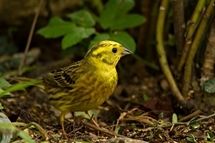 This songbird is unmistakable in the field, with a bright yellow head and belly. Yellowhammers are often seen perched on top of a hedge or bush singing – listen out for their “a little bit of bread and no cheese” song!
This songbird is unmistakable in the field, with a bright yellow head and belly. Yellowhammers are often seen perched on top of a hedge or bush singing – listen out for their “a little bit of bread and no cheese” song!
- Yellowhammer numbers have declined by 42% since 1995
Corn bunting
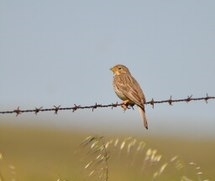 This bunting has a nondescript, brown body, with a wide, finch-like bill for cracking open seeds. Corn buntings tend to perch on wires or posts and will fly between perches with a fluttering style flight and a distinct leg dangle.
This bunting has a nondescript, brown body, with a wide, finch-like bill for cracking open seeds. Corn buntings tend to perch on wires or posts and will fly between perches with a fluttering style flight and a distinct leg dangle.
- Corn bunting numbers have declined by 46% since 1995
Grey partridge
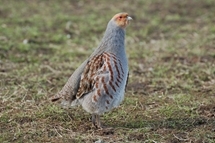 The grey partridge, also known as the English partridge, is a medium sized grey bird, with an identifiable orange face. It is found on the ground in small groups called coveys, which, when startled, will fly low in a whirring style.
The grey partridge, also known as the English partridge, is a medium sized grey bird, with an identifiable orange face. It is found on the ground in small groups called coveys, which, when startled, will fly low in a whirring style.
- Grey partridge numbers have declined by 64% since 1995
Red-legged partridge
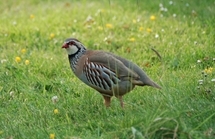 This partridge is much more distinctive than the grey partridge, with a bright white chin and a speckled black throat. Red-legged partridges can be found feeding in groups on the ground and, unlike grey partridges, tend to run when startled.
This partridge is much more distinctive than the grey partridge, with a bright white chin and a speckled black throat. Red-legged partridges can be found feeding in groups on the ground and, unlike grey partridges, tend to run when startled.
Lapwing
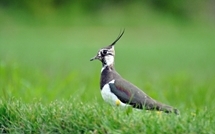 The lapwing is a medium-sized glossy black and white bird with a splendid head crest. They can be easily identified in flight from their round wing shape and unique “peewit” calls.
The lapwing is a medium-sized glossy black and white bird with a splendid head crest. They can be easily identified in flight from their round wing shape and unique “peewit” calls.
- Lapwing numbers have declined by 30% since 1995
Skylark
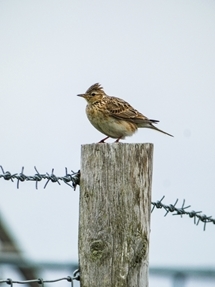 The skylark is a small, streaky, brown bird, that is often seen perched on posts or fences. They have a notable head crest, which they raise in alarm. Listen out for their long, melodic song, which they can sing from over 50m in the air!
The skylark is a small, streaky, brown bird, that is often seen perched on posts or fences. They have a notable head crest, which they raise in alarm. Listen out for their long, melodic song, which they can sing from over 50m in the air!
- Skylark numbers have declined by 25% since 1995
How to get involved
- Download your count sheet from www.bfbc.org.uk. Start thinking about where you want to survey from (it could be from within a vehicle), aiming for a spot where you can see around 2 ha of land. Take a look at the weather and set a date between 3-19 February.
- Count your birds! Record the species you see, and the maximum number of each species seen at one time.
- Submit your results. You can submit your Big Farmland Bird Count results quickly and easily online from 3 February at www.bfbc.org.uk.
In February we will be joining some local landowners for their GWCT Big Farmland Bird Counts. We are all looking forward to seeing what species are sharing their land. It will be especially exciting to see the successes of their environmental efforts, hopefully leading to higher bird numbers than in previous years.